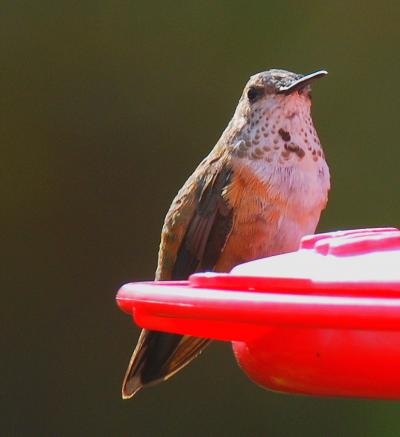
By Terry W. Johnson
One of the most fascinating things about birds is that, since they have wings, they can show up when and where they are least expected. One such bird is the rufous hummingbird.
The rufous hummingbird has the distinction of being the most common hummingbird seen in Georgia during winter. However, often the first fall migrants reach the state in midsummer. While we don’t have any idea how often, I suspect this happens more frequently than we realize.
One reason why is we don’t expect to see a rufous in our backyards when scarlet sage, zinnias, hollyhocks, Turk’s cap and other eye-catching nectar plants are in full bloom. We’re not looking for them.
Also, because most of the rufous hummers reported in Georgia during summer are females and immatures, they blend in with the throngs of ruby-throated hummingbirds that vie with one another for a chance to feed at our hummingbird feeders and the smorgasbord of nectar plants in our gardens. Consequently, we rarely focus our attention on individual birds. I can attest to this because it has happened to me.
My first encounter with a summer rufous took place about a decade ago on a quiet, muggy August morning. Ted Woodward, a former Wildlife Conservation Section employee, was helping me catch and band rubythroats at Georgia DNR offices on Rum Creek Wildlife Management Area near Forsyth. At least 15 to 20 hummers were visiting the feeders lining the front porch of the office. Neither of us had spotted a rufous that summer. However, walking up to a bird fluttering in the trap, Ted said, “Terry, I think we have caught a rufous.” I gently removed the bird from the trap and quickly examined it. Sure enough, Ted was right. We had trapped an immature rufous hummingbird.
Although Ted and I had been watching hummingbirds fly back and forth to the feeder from a large lantana plant, neither of us noticed that one of the hungry hummers was not a rubythroat.
If you carefully study the birds visiting your feeder this summer, and know what you are looking for, maybe you identify one these rare summer visitors. One of the most avid hummingbird enthusiasts I have ever met demonstrated this Several years ago, on a hot August afternoon, she just happened to notice that one of the scores of hummers visiting her feeders seemed different from the rest. She noticed that when the bird fanned out its tail feathers, they were rufous. But ruby-throated hummingbirds don't have brown tails.
You can imagine how thrilled she was to see a bird she had long hope to spot in her backyard: a rufous hummingbird.
Aside from the fact that this marked the first time she had documented a rufous visiting her backyard, the sighting missed by a single day tying the record for the earliest date (Aug. 6) a rufous had been reported in Georgia.
Of course, the rufous is the most common hummingbird seen in the Peach State during winter. An estimated 50 -100 rufous hummingbirds make their way to Georgia each winter. The birds are most often seen from mid-November through mid-February. In fact, if one shows up at a feeder in winter, more than likely it is a rufous.
Rufous hummingbirds nest from Oregon, Washington and Idaho north to southern Alaska – farther north than any other hummingbird. In the winter, the vast majority of birds winter in Mexico. However, for at least half a century, rufous hummingbirds have been regularly wintering in the Southeast.
But there is a chance, as noted, that you may be hosting a rufous right now. The key is being able to identify the species. Here are a few tips that will help.
First, rufous hummingbirds are a tad larger than rubythroats. Also, adult male rufous hummingbirds are easy to identify. They have a coppery red gorget, and extensive areas of rufous-colored feathers on their head, body, back and tail, making them look like they are covered with cinnamon.
The adult female rufous hummer is bejeweled with a central throat patch of orange-red feathers. She also usually displays varying amounts of rufous-colored feathers on her back. The base of her tail is rufous, too. Her sides have a reddish-brown wash.
Immature males and females also have some rufous feathers on their backs. The throats of immature males will be streaked and feature a varying number of rufous feathers. Young females at this time of the year will usually not display a patch of dark feathers on their otherwise white throats.
Who knows? An early rufous hummingbird or other unusual hummingbird visitor might be hiding in plain sight as you read this column. If you are lucky enough to find a rufous in your backyard, it will help make this summer one you will never forget.
Terry W. Johnson is a retired Nongame program manager with the Wildlife Resources Division and executive director of The Environmental Resources Network, or TERN, friends group of the division’s Nongame Conservation Section. (Permission is required to reprint this column.) Learn more about TERN, see previous “Out My Backdoor” columns, read Terry’s Backyard Wildlife Connection blog and check out his latest book, “A Journey of Discovery: Monroe County Outdoors.”




















